Why you can trust TechRadar
One of the most exciting elements of Windows 10 Mobile, and perhaps the biggest USP for the platform, is Continuum – a feature that enables you to use your Windows 10 Mobile phone like a PC.
Or at least that's the way Microsoft has been pitching it. Buy a little box that connects to your TV or PC monitor, plug your phone in and, hey presto, you've got a PC that fits in your pocket.
It makes a lot of sense. Why not have all your data in the same place, and be able to share it simply through the Microsoft ecosystem?
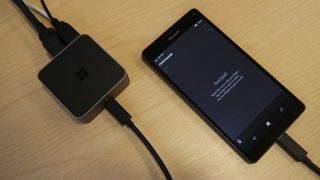
You can buy the Microsoft Display Dock for US$99 (£79.99, AU$149.95), but if you're looking to get a Microsoft Lumia 950 XL it's possible to find deals that throw in the dock for free.
Continuum was simple to set up. I took the dock out of the box, and after a quick search around for a HDMI port (or display port, which I finally settled on), I was able to get it ready to go.
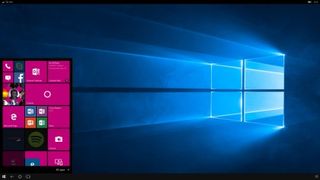
You need to perform a screen size calibration and watch a short introductory clip, and then you're straight into working on your phone much as you would on a PC.
This section of the review was, in fact, written in Continuum using the Microsoft Lumia 950 XL phone and the Microsoft Word app. I plugged my keyboard and mouse into the Display Dock, and the display kept up with what I was typing.

I'd say it's a little laggy compared to what my laptop of capable of, but it's still an enjoyable experience.
One annoying thing is that the app you're working in on your main display will appear on your phone screen as well.
While typing I was constantly seeing autocorrect prompts popping up on the phone in my peripheral vision, which became really annoying. I tried turning the screen off, but the whole system went into low power mode.
This means your phone screen needs to be always on, so that you can use it like a touchpad to navigate around the software.
If you're using your phone for a few moments to set up a video clip that's fine, but if you're trying to be productive then you're likely to plug in a mouse, so you won't need your phone to be on as well.
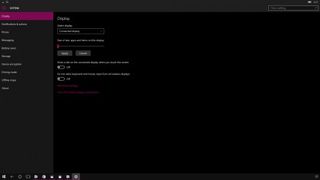
That said, the touchpad functionality is responsive and simple to use, with a two-finger motion for dragging and a simple tap when you want to open an app.
It's the easiest way to use Continuum without a mouse, but if you want to be any way productive you'll want a keyboard and mouse to make the whole process easier.
Apps blow up to the size of the screen you're using – this is how the mobile version of techradar.com looks when displayed on a screen via the Display Dock.
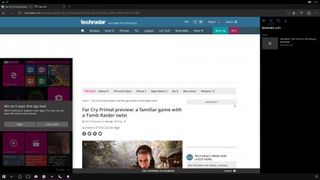
While writing this Continuum did crash once – by the time I had reconnected, all my apps were shut down and I was back to square one. Fortunately Microsoft Word saves your work automatically, but I lost all my open tabs and what apps I was using.
This is an issue that needs to be sorted out – Continuum is a feature that's aimed at professionals who won't be so tolerant of crashes in the middle of their hard work.
On the phone home screen that appears on your working display you'll see all the apps available to you in Continuum. This looks much like your phone's home screen does ordinarily, but a few apps are faded out as Continuum doesn't support them yet.

And that's the real problem with Continuum right now. A lot of the key Microsoft apps are here and ready to roll, including Word, Excel, Edge and Photos, but a lot of other apps aren't supported yet.
Even Skype isn't supported, and that's a Microsoft-owned application. You'd think that the ability to pull up Skype on your home TV with the help of your phone would be a killer feature many users.
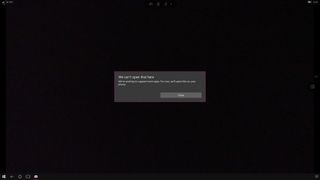
You'll only want Continuum right now if you need word processing or spreadsheets to be as accessible on your phone as they are on your work computer – but that's something OneDrive already offers.
As more and more apps are supported by the service Continuum will become more useful, but for now you're often frustrated; I wanted to be able to play some games on my TV or monitor, but – surprise, surprise – they aren't ready yet.
It's always the same problem with Windows Phone.
When an app isn't supported by Continuum you have the choice of opening it on your phone, but that's largely useless if you want it on the big screen. If I wanted to use it on my phone I'd just disconnect it from the dock and get on with it.

Continuum and the Display Dock are great ideas. It's taking the concept of AirPlay and Chromecast to a whole new level, and making it useful for those who want to work as well as play.
Being able to type using a keyboard and large screen and have that information saved to my phone is great. But right now it's not enough to make it worth buying a Display Dock with your Windows 10 Mobile phone, and it's certainly not a big enough selling point to justify buying a Lumia handset.
James is Managing Editor for Android Police. Previously, he was Senior Phones Editor for TechRadar, and he has covered smartphones and the mobile space for the best part of a decade bringing you news on all the big announcements from top manufacturers making mobile phones and other portable gadgets. James is often testing out and reviewing the latest and greatest mobile phones, smartwatches, tablets, virtual reality headsets, fitness trackers and more. He once fell over.


